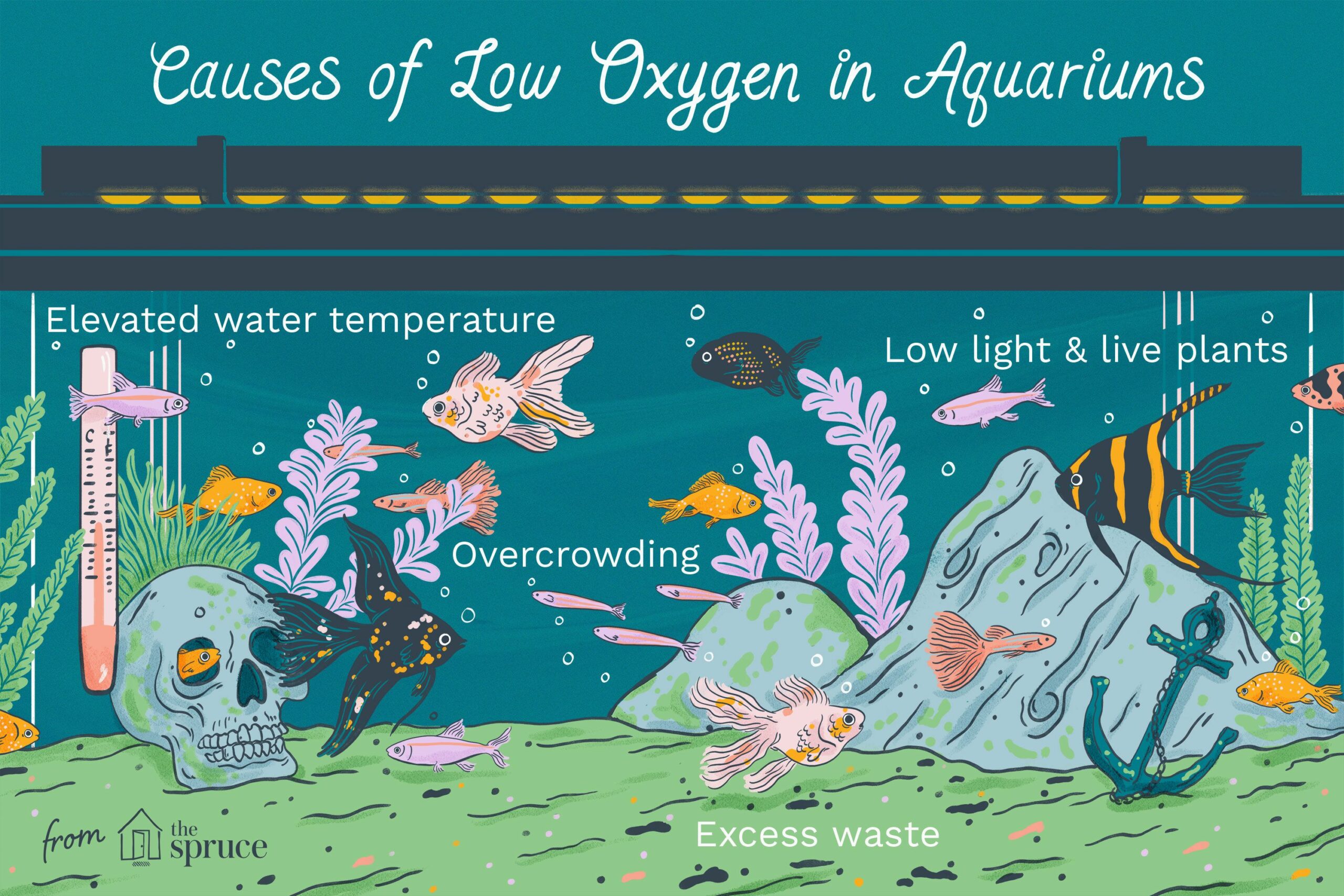To add oxygen to a fish tank, you can follow these steps:
1. Check the water quality: Before adding more oxygen, it is important to ensure that your fish tank water is in optimal condition. Test the water parameters such as pH, ammonia, nitrite, and nitrate levels using an aquarium test kit, and take necessary actions if any parameter is off.
2. Increase surface agitation: Oxygen exchange primarily occurs at the water’s surface. Increasing the surface agitation will enhance oxygen transfer to the water. You can achieve this by using an air stone, airstone with an air pump, or a bubble curtain. These devices create bubbles and disturb the water surface, promoting oxygen diffusion.
3. Use a hang-on-back filter: Hang-on-back (HOB) filters are equipped with a water outlet nozzle that breaks the water’s surface, promoting oxygenation. By using an HOB filter, you can ensure proper oxygenation while also providing filtration for the tank.
4. Install a sponge filter: Sponge filters not only provide biological and mechanical filtration but also create water movement at the surface, which aids in oxygenation. They are particularly useful in small aquariums or with fry or shrimp tanks.
5. Add live aquatic plants: Live plants produce oxygen during photosynthesis, increasing the tank’s dissolved oxygen levels naturally. Apart from providing oxygen, plants also offer other benefits such as stress reduction for fish and water clarification.
6. Avoid overstocking: Overstocking a fish tank can lead to oxygen depletion due to increased oxygen demand from fish and decaying waste. Maintaining a proper fish-to-water ratio is crucial for maintaining oxygen levels.
7. Clean the tank regularly: Regularly cleaning the tank helps remove waste, excess nutrients, and uneaten food that can consume oxygen as they decompose. Performing partial water changes and gravel vacuuming are essential steps in maintaining good water quality and oxygen levels.
8. Consider an oxygen pump or diffuser: In certain cases, such as highly stocked tanks or in warm water conditions, additional oxygen may be required. You can use an air pump with an air stone or a diffuser to increase oxygen levels. However, be cautious not to create excessive water movement or disturb fish.
Remember, it is crucial to find the right balance of oxygen for the specific needs of your fish and tank. Monitoring the fish behavior and regularly testing water parameters will help you maintain a healthy and oxygenated environment for your aquatic pets.
Know More About: how to add oxygen to fish tank
Adding Oxygen to Your Fish Tank for a Healthy Aquatic Environment
Introduction:
Maintaining a healthy and thriving fish tank requires more than just water, fish, and decorations. One crucial element that is often overlooked is oxygen. Just like humans, fish need oxygen to survive, and as a responsible fish tank owner, it is your duty to ensure their environment is adequately oxygenated. In this blog post, we will explore some effective methods for adding oxygen to your fish tank, promoting the well-being and longevity of your aquatic pets.
1. Invest in an Aquarium Air Pump:
One of the most efficient ways to add oxygen to your fish tank is by using an aquarium air pump. This small device works by creating surface agitation, causing water movement that increases the gas exchange between water and air. Attach an air stone or a bubble wand to the air pump to maximize the oxygen diffusion throughout the tank. Additionally, air pumps promote water circulation, reducing the risk of stagnant areas where low oxygen levels can be harmful to your fish.
2. Utilize Air Stones and Bubble Wands:
Air stones and bubble wands are essential tools that help disperse the air pumped into your tank. By breaking the air into smaller bubbles, these accessories increase the surface area of the water exposed to the airstream, enhancing oxygenation. Place them strategically across the tank to ensure even distribution of oxygen throughout the water column. Remember to clean them regularly to prevent blockage caused by debris or algae growth.
3. Improve Water Movement with a Water Pump:
Another effective way to add oxygen to your fish tank is by incorporating a water pump. By creating currents and increasing water circulation, a pump prevents oxygen depletion in certain areas, ensuring that all fish have access to sufficient oxygen levels. Depending on the size of your tank, choose a water pump with an appropriate flow rate to maintain the equilibrium necessary for healthy fish.
4. Increase Surface Agitation:
Surface agitation is crucial for oxygen exchange within your tank. You can achieve this by using various methods, such as adjusting the water flow from your filter outlet or placing decorations in the tank that create gentle currents. Using a spray bar or an attachment to disperse the filter outlet flow can increase surface agitation, promoting efficient oxygenation.
5. Avoid Overstocking the Tank:
Maintaining a proper fish-to-water ratio is essential for maintaining adequate oxygen levels. Overstocking the tank can result in oxygen depletions, leading to stressed and unhealthy fish. Research the specific needs and compatibility of the fish species you plan to keep and ensure that your tank can accommodate them comfortably.
6. Trim Aquatic Plants:
Aquatic plants play a vital role in oxygen production within your fish tank. Through the process of photosynthesis, they release oxygen into the water while absorbing carbon dioxide produced by fish. Regularly maintaining and trimming your aquatic plants not only keeps your tank aesthetically pleasing but also promotes optimal oxygenation for your fish. Be cautious not to remove or damage too many plants at once, as they are necessary for maintaining a stable ecosystem.
Conclusion:
Ensuring proper oxygenation within your fish tank is crucial for the overall health and well-being of your aquatic pets. By utilizing an air pump, air stones, water pumps, increasing surface agitation, maintaining appropriate stocking levels, and trimming aquatic plants, you can create an oxygen-rich environment that supports the thriving life within your tank. Remember, a well-oxygenated fish tank promotes happy and stress-free fish, ultimately leading to a visually appealing and harmonious aquatic ecosystem.
FAQs on how to add oxygen to fish tank
1. Why is adding oxygen to my fish tank important?
Adding oxygen to your fish tank ensures that your fish have enough oxygen to breathe, promoting their health and well-being.
2. How can I add oxygen to my fish tank?
There are a few ways to add oxygen to your fish tank, including using an air stone or diffuser, a sponge filter, or a surface skimmer. These devices agitate the water’s surface, increasing oxygen exchange.
3. Can I use plants to add oxygen to my fish tank?
Yes, aquatic plants play a crucial role in oxygenating the water. They release oxygen into the tank through photosynthesis, making them a natural and effective way to add oxygen to your fish tank.
4. How often should I add oxygen to my fish tank?
Oxygen should be consistently available in your fish tank. Therefore, it is recommended to keep the oxygenating devices running 24/7 to ensure a continuous flow of oxygen.
5. How do I know if my fish tank has enough oxygen?
If your fish are gasping for air at the water’s surface or showing signs of stress, such as becoming lethargic or displaying rapid gill movements, it may indicate insufficient oxygen levels. Testing kits are also available to measure oxygen levels in the water.
6. Can I over-oxygenate my fish tank?
While it is essential to provide adequate oxygen, it is possible to over-oxygenate the tank, causing stress to your fish. Monitor your fish’s behavior and look for signs of excessive oxygenation, such as bubbles constantly rising to the surface.
7. Does water movement contribute to oxygenation?
Yes, water movement plays a significant role in oxygen exchange. Using a water pump or filter that creates surface agitation will help increase oxygen levels in your fish tank.
8. Should I clean my aerating devices regularly?
Yes, aerating devices, like air stones or diffusers, should be cleaned regularly to maintain their efficiency. Follow the manufacturer’s instructions for proper cleaning procedures.
9. Can I use a regular air pump to add oxygen to my fish tank?
Yes, a regular aquarium air pump can be used to power aerating devices. However, choosing the right-sized air pump for your tank is key, as too powerful or too weak a pump may affect oxygen levels.
10. Are there any alternative ways to add oxygen to my fish tank?
Besides using aerating devices, you can also increase oxygen levels by keeping the temperature stable, avoiding overcrowding your tank, performing regular water changes, and ensuring efficient filtration.

